The sympathetic & parasympathetic nervous systems are two components of the autonomic nervous system. These are responsible for controlling and manipulating our involuntary actions. We can differentiate SNS and PNS depending on their responsibilities and action potential.
The SNS mobilises the body in stressful situations such as danger, sports, and fights. Thus, it triggers a “fight or flight” response.
The PNS helps to produce and preserve the body’s normal homeostasis. Thus, it functions to prepare the body for a ‘rest and digest response.
SNS in an active state urges the body to produce an intense amount of energy for physical activity. The PNS inhibits high-energy activities and restores the body’s calm and composed condition.
In this context, we will provide you with the major differences between the SNS and PNS.
Content: Sympathetic Vs Parasympathetic Nervous System
- Comparison Chart
- What is Sympathetic Nervous System?
- What is Parasympathetic Nervous System?
- Key Differences
- Summary
Comparison Chart
| Basis of Comparison | Sympathetic nervous system | Parasympathetic nervous system |
|---|---|---|
| Meaning | Part of autonomic nervous system that regulates the fight-or-flight response of the body. | Part of autonomic nervous system that controls the general homeostasis i.e. rest-and-digest response of the body. |
| Location | Originates in thoracic and lumbar region. | Originates from cranial region of brain stem and sacral region of spinal cord. |
| Function | Mobilises the body for intense physiological action i.e. makes the body alert, tensed up and speeded towards danger. | Restores the body to go in the relax mode by restricting the high energy activities. |
| Response | Quick | Slow |
| Position of Ganglion | Close to the central nervous system (CNS). | Away from CNS, close to effector. |
| Pre-ganglion fibres | Short | long |
| Post-ganglion fibres | long | Short |
| Coverage and effect of body | Covers the larger area of the body with diffused effect at the target zone. | Covers the smaller area of the body with localised impact on the target area. |
| Outflow | Generates a thoracolumbar outflow. | Generates a craniosacral outflow. |
| Nerves | Adrenergic | Cholinergic |
| Neurotransmitters | Secretes Adrenaline or noradrenaline | Secretes acetylcholine. |
| Cardiovascular system | Enhances the blood pumping in the heart, thus increasing the heart rate. | Relaxes the cardiac muscles, decreasing the heart rate. |
| Respiratory system | Dilates the respiratory airway, increases the breathing rate. | Constricts the respiratory tract, decreases the respiration rate |
| Pupillary action | Pupils dilate | Pupils constrict |
| Sensory awareness | Raises the sensory response | Keep the sensory responses in the normal state |
| Glycogen breakdown | Stimulates the glycogen breakdown mechanism | Does not affect glycogen breakdown |
| Digestive system | Decreases the stomach movements and slow down the digestion process | Increases the stomach movement and fasten the digestion machinery |
| Urinary system | Decreases the urinary output | Increases the urinary output |
| Importance | Produces swift, spontaneous and sudden response in danger or excited state. | Maintains the normal homeostasis of the organism's body. |
What is the Sympathetic Nervous System (SNS)?
The SNS is one of the components of the autonomic nervous system (ANS). This prepares the body to respond in:
- Emergency situations
- Stressful activities
- In the event of a threat
- High-level physical activity such as fighting or sports.
SNS mediates neuronal and hormonal responses for the above situations. And thus it triggers the “fight or flight” response.
Constituents of Sympathetic Nervous System
The SNS is a complicated network of preganglionic, postganglionic neurons and ganglions.
Axons of short preganglionic neurons extend to ganglia in the thoracic and lumbar regions. Whereas axons of lengthy postganglionic neurons extend from the ganglia to the target organ. Thus, we refer to the fibres of SNS efferent neurons as ‘Thoraco-lumbar outflow’.
- Preganglionic neurons: Also known as presynaptic. They arise straightaway from the thoracic and lumbar regions of the spinal cord. Later they synapse in the ganglia.
- Postganglionic neurons: Also referred to as postsynaptic neurons. These neurons originate from the ganglia and extend up to the targeted region. In the targeted region, they trigger the required response.
There are many ganglions in various zones. But three of them are particularly important for the notable SNS responses:
- Sympathetic chain
Sympathetic chain ganglia lie beside the vertebral column (within the paravertebral region). The chain runs from the upper neck zone to the coccyx domain. And here they develop the coccygeal ganglion. This chain comprises bunches of 20-30 thousand of nerve cells. And they aid the transmission of information to the targeted body organ. - Celiac ganglions
Preganglionic neurons from the spinal cord synapse with celiac ganglions. These neurons innervate the upper abdominal organs. For example, stomach, liver, and intestines. - Inferior mesenteric ganglions
Sympathetic neurons arising from the lumbar region synapse in the inferior mesenteric ganglia. The postganglionic nerves emerging at this point activate organs of lower abdomen viscera. Like, the adrenal gland, urine bladder, and genitals.
Neurotransmitters involved in the sympathetic nervous system
- Some specific neurons release Neurotransmitters that act as messengers. Preganglionic neurons emit acetylcholine (Ach), which is a primary neurotransmitter.
- Preganglionic neurons secrete acetylcholine at the point of synapse within the ganglia. The acetylcholine is then delivered to the postganglionic neurons’ receptors. This procedure triggers the production of the neurotransmitter norepinephrine. Now this norepinephrine extends signals to the targeted body organ.
- Noradrenaline is another name for norepinephrine. The adrenal medulla secretes noradrenaline after prolonged activation from postsynaptic neurons. It prepares the body and brain for the fight or flight response and improves alertness and focus.
- Epinephrine or adrenaline is also secreted due to the neuronal effect of SNS.
- These two neurotransmitters encourage SNS to generate the optimal response in stressful conditions. They improve blood flow, increase oxygen intake, and greater energy production etc.
- Thus, adrenaline and noradrenaline mediate the body to produce flight and fight responses.
Responses produced by Sympathetic Nervous System
The sympathetic nervous system activates in case of urgency, danger or physical exercise. Thus, it enhances the body’s speed, alertness and level of stress. SNS stimulates all the systems that are crucial for survival. In contrast, it shuts or slows down the other less necessary processes.
In an active state, SNS stimulates some of the specific mechanisms which are as follows:
- Increased Heart rate: SNS induces the heart to flow extra blood throughout the body. Due to this, the heart pumps the blood at an increased pace.
- Pupil dilation: SNS aids pupil dilation making vision sharper to promote alertness.
- Relaxation of the air passage: The SNS dilates the bronchial tubes to pass excess air. This meets the demand for additional oxygen for cellular respiration. This results in an increased respiratory rate.
- Glycogen Breakdown: The body requires energy for an intensive workout or escaping danger. As a result, the SNS accelerates the breakdown of glycogen into glucose. This glucose is further used for energy production.
- Inhibits salivation: SNS also hampers salivation as it is a less important process. This results in a dry tongue during stressful situations.
- Reduced urine production: SNS restricts urination to retain hydration and conserves energy.
- Inhibits digestion: The digestive process requires a lot of energy. Thus, SNS inhibits digestion by lowering the stomach motions.
- Increases Intestinal Absorption: The body needs more energy for physical work. Hence SNS boosts nutrient absorption in the intestines.
What is the Parasympathetic Nervous System?
The PNS counteracts the responses of the SNS. As it recovers energy and maintains the body’s calm and serenity. Thus we refer to the response elicited here as rest and digest response.
Constituents of the Parasympathetic Nervous system
The nerves of PNS originate from the cranial region of the brain stem and sacral regions of the spinal cord. So we refer to it as ‘Cranio-sacral outflow”.
The parasympathetic system also comprises the pre and post-ganglionic neurons. Presynaptic neurons are longer and myelinated. In comparison, the postsynaptic neurons are shorter and non-myelinated.
- Cranial Nerves: The prime nerves that originate from the cranial part are:
- CN III i.e., the oculomotor nerve
- CN VII i.e.,facial nerve
- CN IX i.e., Glossopharyngeal nerve
- CN X i.e., vague nerve
CN III causes the constriction of pupils. The CN VII and CN IX stimulate salivation as they target salivary glands. While CN X nerve governs and targets most of the systems involved in PNS.
- Sacral Nerves: Along with these, three of the nerve of PNS emerge from the sacral region of the spinal cord. These are sacrum 2 to sacrum 4 (S2-S4). They are also known as ‘Pelvic splanchnic nerves”. These PNS nerves control the activity of the lower abdominal organs. For example, the intestine (rectum), urinary bladder and genitals.
Primary ganglions of the Parasympathetic nervous system
- Ciliary ganglions: They are bundles of nerves situated right behind the eye. These contain postsynaptic neurons that supply the pupillary sphincter muscle. They constrict the pupils and make the lens more convex.
- Pterygopalatine ganglion: It is a PNS ganglion located in the pterygopalatine fossa. a cluster of the facial nerve (petrosal nerve) innervates pterygopalatine ganglia. The axons of these nerves pass via the nasal mucosa and lacrimal glands.
- Submandibular ganglion: Also known as a submaxillary ganglion. Usually, their nerves extend to the salivary glands and are present in the head and neck region.
- Otic ganglions: Situated in the infratemporal fossa below foramen ovale. Regulates salivation in conjunction with the parotid glands and mandibular nerves.
Neurotransmitters of Parasympathetic nervous system
- The most crucial neurotransmitter of the PNS is acetylcholine. At the point of synapse within the ganglia, presynaptic neurons secrete ‘acetylcholine’. The postsynaptic neurons then absorb the acetylcholine. This mechanism activates the body’s rest and digest reaction.
- In an active state, PNS let the postganglionic nerve secrete Ach. This Ach is stored in the neuron vesicles. This neurotransmitter reaches the surrounding muscles of the targeted organ. Thereby, opening channels for the passage of positively charged sodium ions.
- The high-frequency nerve impulses due to this sodium channel will cause muscles contraction. This acetylcholine results in:
- Decreasing the heart rate
- Increasing the stomach movement
- Stimulates the digestive process
- Slow down the breathing rate
Responses of the parasympathetic nervous system
- Decreased Heart Rate: The PNS relaxes the cardiac muscles. It slows down the blood pumping to calm the body and restore energy by decreasing the heart rate.
- Constricts pupils: The PNS contract or normalize the pupils and the lenses.
- Constricts Bronchial tubes: In the relaxed state, the body requires less oxygen. Thus, PNS constricts the air passage slowing the pace of breathing.
- Muscle relaxation: In an active state PNS relaxes the tensed muscles. This restores energy wasted during the sympathetic reaction.
- Induces salivation: PNS resumes the salivation process restricted during sympathetic response.
- Increases digestive secretions: PNS increases the movements of the stomach, stimulating digestion. It also boosts the release of digestive enzymes.
- Increase urine production: PNS resumes the process of urination slowed down during SNS.
Key Differences Between Sympathetic and Parasympathetic nervous system
- SNS and PNS both are parts of the ANS, but they function in the opposite situations. The SNS work in stressful emergencies or during high-level physical exercise. Whereas, the PNS is active when the body is in the relaxed mode.
- The sympathetic nervous system produces the ‘fright, flight or fight response. However, the parasympathetic generates the ‘rest and digest responses.
- Nerves of the SNS originate from the thoracic and lumbar regions. So, we refer to it as Thoraco-lumbar outflow.
On the contrary, PNS emerge from the cranial part of the brain stem as well as the sacral region of the spinal cord. We refer to this outflow as Cranio-sacral outflow. - Sympathetic comprises short and non-myelinated presynaptic neurons and long and myelinated postsynaptic neurons. However, parasympathetic forms longer and myelinated presynaptic neurons and shorter and non-myelinated neurons.
- The prime neurotransmitters of the SNS are adrenaline (epinephrine) and noradrenaline (norepinephrine). Whereas, acetylcholine is the major neurotransmitter in the case of the PNS.
- A sympathetic response slows down all the unnecessary systems and processes. Like salivation, digestion, urination. It stimulates vital life functions like increased heart rate, breathing rate, vision, and awareness.
The parasympathetic response tries to maintain the calm and composure of the body. Thereby restoring the normal homeostasis between the life processes.
Summary
We can classify the ANS into two prominent types- sympathetic and parasympathetic. Belonging to the same nervous system, they differ in their functions and responsibilities.
Sympathetic on one side reacts when you are playing, fighting or in emergencies. In contrast, Parasympathetic becomes active when you are relaxing.
Both nervous systems are of equal importance as they counterbalance each other’s responses.

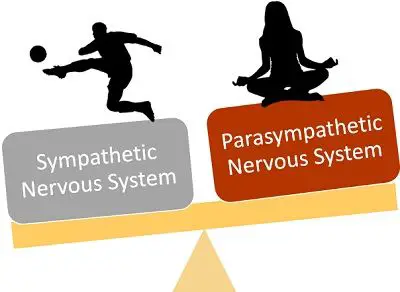

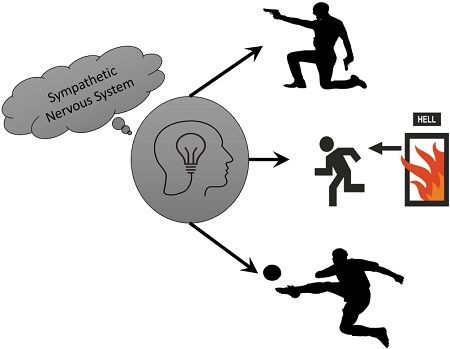
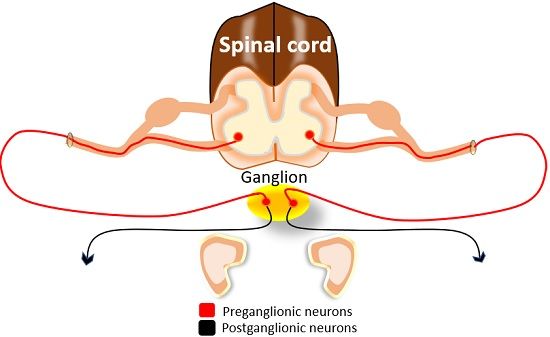
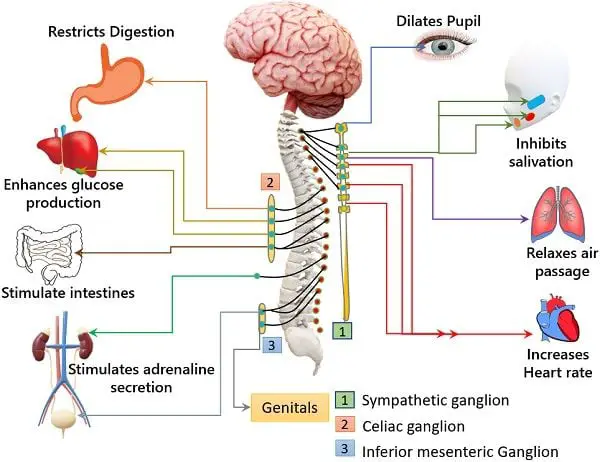
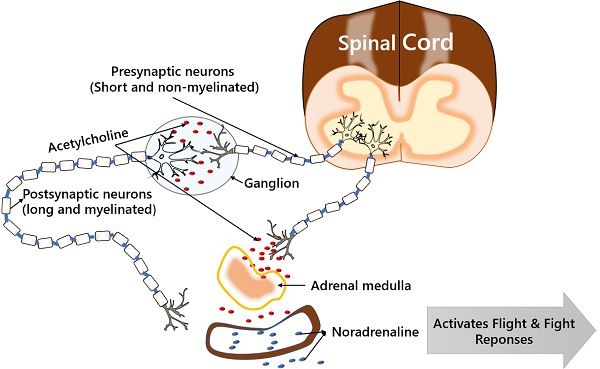
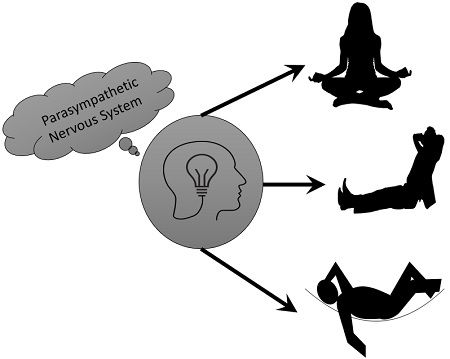
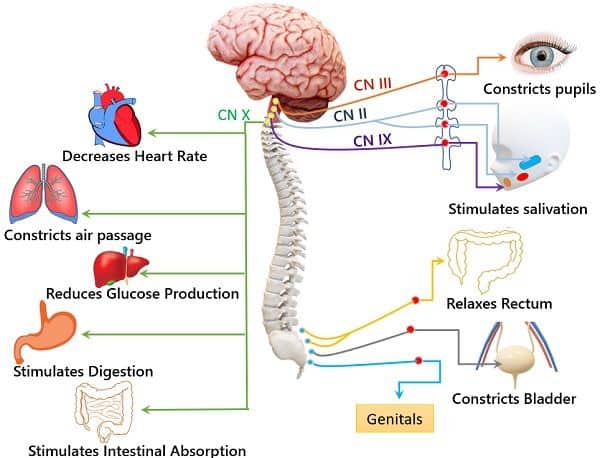
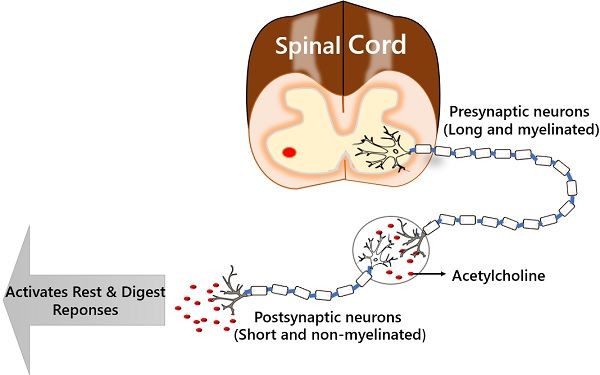
Leave a Reply